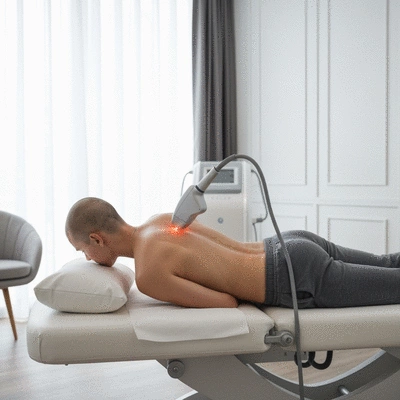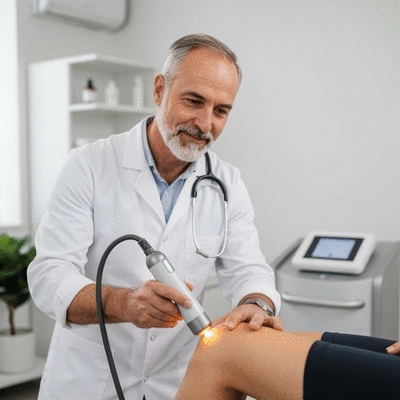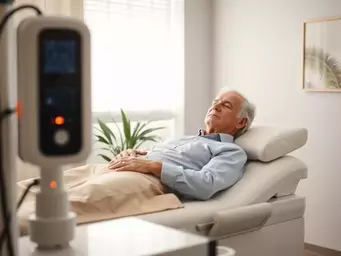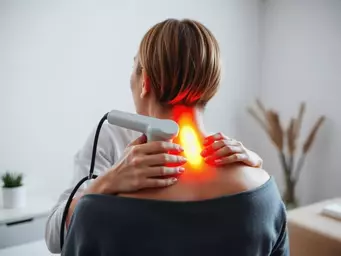Treatment Process Overview
- • Assessment: Thorough evaluation by professional.
- • Positioning: Patient comfort for laser treatment.
- • Application: Laser targets areas (20-30 mins).
- • Follow-up: Next steps and future appointments.

Consider this: millions live with chronic pain, battling not only discomfort but also emotional distress each day. What if effective management strategies could empower these individuals to reclaim their lives? This article explores the nuances of chronic pain and innovative solutions like low-level laser therapy (LLLT) that are transforming pain management.
This visual outlines the step-by-step process of Erchonia Laser Therapy and highlights the benefits of non-invasive treatment options for chronic pain management.
Chronic pain affects millions of people worldwide, transforming their daily lives and routines. It’s more than just a physical sensation; it can lead to emotional distress and a decline in overall well-being. In my years of experience with patients, I’ve seen how chronic pain can limit mobility, disrupt sleep, and cause anxiety. Understanding this condition is vital to finding effective management strategies.
So, what exactly is chronic pain? It’s defined as pain that lasts for more than three months. Unlike acute pain, which serves as a warning signal, chronic pain often lingers without a clear cause. This ambiguity can be frustrating for individuals seeking relief, as they may feel trapped in a cycle of discomfort.

Living with chronic pain significantly alters one's quality of life. Many patients find themselves managing daily tasks with great difficulty, often leading to feelings of helplessness. Here are some of the most common ways chronic pain impacts daily living:
It's essential to acknowledge these challenges. When we discuss the importance of effective pain management, we’re talking about enabling individuals to reclaim their lives and reduce the burdens associated with chronic pain.
Traditional pain management often relies on medications, physical therapy, and sometimes surgical interventions. While these methods can provide temporary relief, they aren't without drawbacks. Many patients experience side effects from medications, such as dependency or gastrointestinal issues. Additionally, not all patients respond positively to standard therapies.
In my practice, I’ve observed that many individuals are seeking alternatives to traditional pain management. It’s crucial to explore the limitations of conventional methods, as they may not address the underlying causes of chronic pain. Instead, they often focus on masking symptoms, which can lead to frustration and a lack of long-term solutions.
As a proponent of non-invasive healing solutions, I’m excited to discuss the potential of innovative therapies like low-level laser therapy (LLLT). Non-invasive treatment options can provide significant benefits, such as:
It’s clear that exploring alternatives like LLLT can empower those suffering from chronic pain by offering safer, effective options for relief. As we continue to advance in pain management, I believe we’ll find even more ways to support individuals on their healing journeys.
What has been your experience with chronic pain management? Have you explored non-invasive treatments like Erchonia Laser Therapy? Share your thoughts below:
As you consider Erchonia Laser Therapy for chronic pain relief, it’s essential to understand what the treatment process entails. Knowing what to expect can help ease any concerns and prepare you for your journey towards wellness. The therapy sessions are designed to be straightforward, with an emphasis on patient comfort and effectiveness.
During your first visit, a qualified practitioner will assess your condition and discuss your medical history. This personalized approach is crucial for tailoring the treatment to your specific needs. Once you're ready to begin, the actual therapy involves a series of non-invasive laser applications that target the affected areas.

Typically, the treatment process for Erchonia Laser Therapy includes several key steps:
It’s a gentle process, and many patients report feeling a sense of warmth or tingling, but no pain during the therapy.
To achieve optimal results, the frequency of therapy sessions will depend on your individual circumstances. Many patients start with 2 to 3 sessions per week, progressively reducing frequency as pain diminishes.
Here are some tips for maximizing the benefits of your Erchonia Laser Therapy:
By actively engaging in your treatment, you can foster a more effective recovery journey.
Every patient is unique, which is why the treatment protocols for Erchonia Laser Therapy are tailored to fit individual needs. Practitioners will typically follow established guidelines that focus on safety and effectiveness. For instance, studies on clinical trials often explore patient-specific responses to LLLT, highlighting its personalized nature. Furthermore, research on low-level laser therapy for pain continues to refine these protocols, emphasizing the importance of individualized treatment plans.
Here’s what you might expect regarding treatment protocols:
Regular evaluations will help adjust the treatment plan as needed, ensuring that you are on the right path to recovery.
Understanding Red Light Therapy

Curious about how light can play a pivotal role in healing? The world of light therapy is rich with
Erchonia Laser Therapy for Pain Management

Curious about a non-invasive solution to chronic pain? Erchonia Laser Therapy is emerging as a revol
Relieving Neck and Shoulder Pain

Consider this: neck and shoulder pain affects millions, yet many are unaware of the root causes. Und
Understanding Red Light Therapy
Erchonia Laser Therapy for Pain Management
Relieving Neck and Shoulder Pain
Erchonia Laser and Back Pain Outcomes
Exploring Erchonia's Laser Technology Science